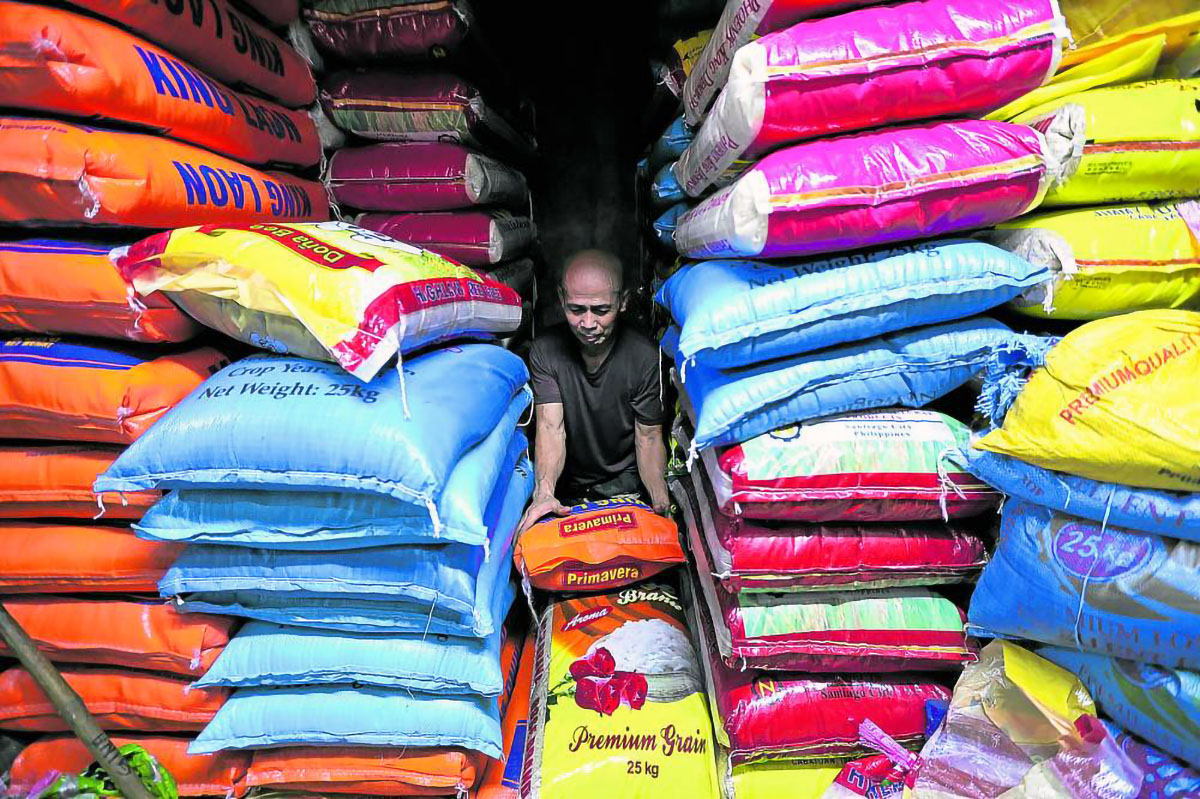
RELIEF FOR CONSUMERS Rice prices are expected to decline next month once imports at a reduced tariff start arriving in the country. —Grig C. Montegrande
MANILA, Philippines — Consumers can start benefiting from lower rice prices as early as next month following the government’s decision on Tuesday to slash the tariff on imports, the Department of Agriculture (DA) said on Wednesday.
“We will do everything within our power, especially those granted to the (DA) under the Price Act, to make sure the substantial cut in rice tariff will translate to a significant reduction in the retail price of the grain,” Agriculture Secretary Francisco Tiu Laurel Jr. said in a statement.
Agriculture Assistant Secretary Arnel de Mesa said in a media briefing that consumers could start buying rice at reduced prices by July at the earliest or August at the latest.
READ: Marcos approves cut in rice tariff to 15%
“Probably in a month’s time we can expect the price reduction. If it will be implemented [immediately], we can expect changes in selling prices within July because it’s only June now,” he told reporters, noting that it normally takes about two to three weeks before rice imports, particularly from Vietnam, arrive in the country.
The Philippine Statistics Authority on Wednesday said it expected a decrease of P6 to P7 a kilo due to the tariff reduction, while National Economic and Development Authority (Neda) Secretary Arsenio Balisacan earlier noted that rice prices could go as low as P29 for poor households.
READ: Rice tariff cut to ease upward pressure on prices, says Neda chief
Farmers not happy
However, the agricultural group Federation of Free Farmers (FFF) said the tariff cut was a “stab in the back” and spelled the likely “death blow to the country’s three million rice farmers and the rice industry as a whole.”
“That the tariff [cut to 15 percent from 35 percent] on rice [imports] will provide major and lasting relief to consumers is more a shot in the dark than a probable result,” FFF national manager Raul Montemayor said.
“Meanwhile, the impact of Neda’s decision on the morale and productive efforts of our rice farmers will be hugely discouraging,” he said in a Viber message, referring to the approval on Tuesday by the Neda board, which is chaired by President Ferdinand Marcos Jr., of the new Comprehensive Tariff Program (CTP) from 2024 to 2028 that cut rice tariff and kept the prevailing low rates on other agricultural products.
Montemayor noted that the country’s reliance on rice imports has increased but retail prices have also risen.
“Our experience since trading in the rice industry was liberalized under the Rice Tariffication Law and tariffs were lowered also on non-Asean rice imports has not been salutary,” he said.
Montemayor added that industry stakeholders were “deprived” of their right “to genuine consultation and due process,” pointing out that the usual procedure in deliberating on any proposed tariff changes was not followed wherein the Tariff Commission conducts hearings on such proposals before submitting recommendations to the Neda board.
FFF has claimed that the tariff cut could result in a P33-billion loss to rice farmers and has voiced concerns about lower tax revenues from rice imports, the proceeds of which are legally earmarked for rice farmers’ productivity programs.
Subsidies, safeguards
In a bid to alleviate the plight of farmers, a group of Filipino-Chinese businesses on Wednesday called on the government to provide subsidies.
Cecilio Pedro, president of the Federation of Filipino Chinese Chambers of Commerce and Industry Inc. (FFCCCII), said they expected local farmers to suffer from lower prices for their output once domestic supply is boosted by imports made cheaper by the tariff cut.
“So, the suggestion is for the government to subsidize. The government should buy the palay from the farmers at a little higher [price] as support for our farmers,” Pedro said.
For its part, the DA said it would seek to fill through the agency’s budget the potential shortfall in the funding for the Rice Competitive Enhancement Fund (RCEF).
“Our priority is to ensure that our rice farmers will continue to benefit from the Rice Fund created under the Rice Tariffication Law, and is confident it will be extended until 2030 to improve the lives of millions of impoverished rice farmers,” Tiu Laurel said.
Some P10 billion from rice tariff collections are earmarked annually for the RCEF, which is used to provide high-yielding seeds, empower farmers through various training sessions, distribute farm machinery, and offer credit support.
Official data showed that as of last month, the fund had a balance of P16 billion.
The DA also said certain safeguards were in place to protect local farmers, including a stricter monitoring of the entry of illegally imported food products, especially rice.
Consumers to benefit
Despite the impact on local farmers, the FFCCCII is supporting the tariff reduction, noting that this has the potential to address inflation that has burdened Filipino consumers.
Lawmakers also welcomed the tariff cut on rice imports, with Speaker Martin Romualdez noting that the tariff reduction was aligned with the administration’s commitment to make rice affordable for Filipinos.
“The import levy reduction and the direct sale of imported rice by the government through its Kadiwa centers should bring down the retail price of rice substantially, especially for consumers,” he said.
House Assistant Majority Leader and Zambales Rep. Jay Khonghun described the President’s decision as “a much-needed relief for our countrymen.”
“It is a clear indication of his administration’s focus on making essential commodities affordable and accessible to all Filipinos. This move will help stabilize rice prices and prevent any potential supply issues,” Khonghun said.
“This policy will help mitigate the effects of inflation and ensure that rice remains affordable for everyone,” added Davao Oriental Rep. Cheeno Miguel Almario.
House Deputy Minority Leader and Basilan Rep. Mujiv Hataman, meanwhile, was cautiously optimistic about Neda’s predictions that the new policy could bring down rice prices from P50 to P29. —with a report from Krixia Subingsubing